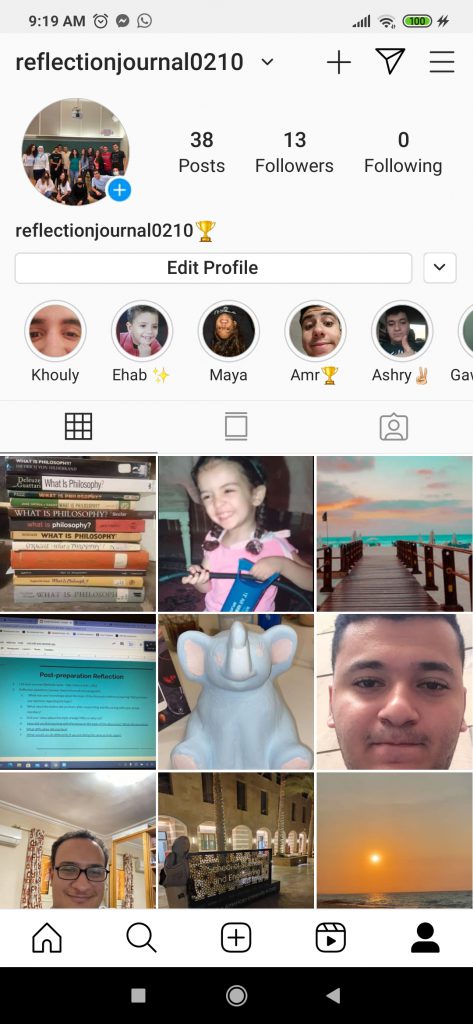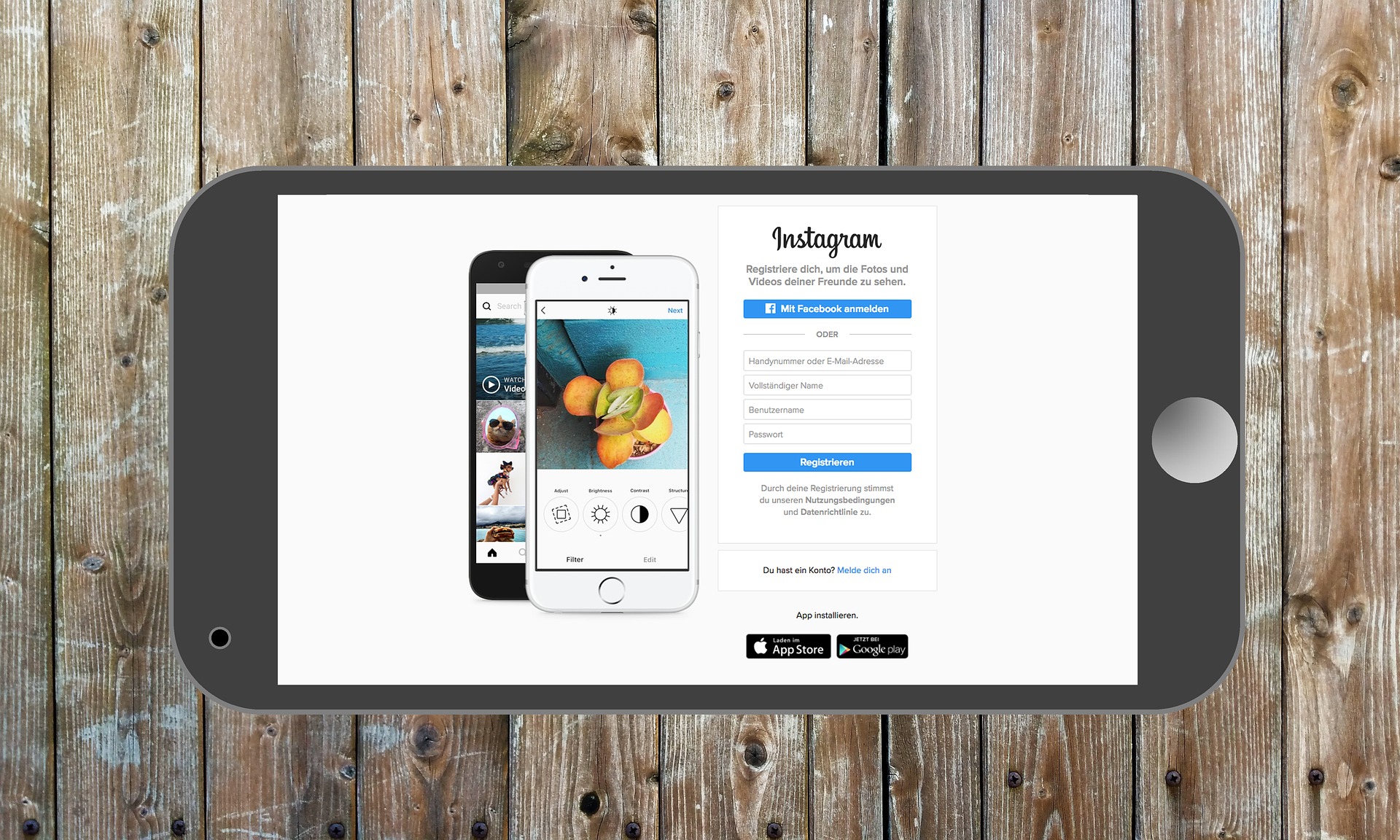#TheBeginning
I was reading one of the New Chalk Talks in my office about Hanan Kholoussy using Instagram to post for wellness during the COVID-19 period when I had my Eureka moment: Instagram! My students were expected to write a final reflection paper in their 0210 course in the ELI program and the original plan was to have them prepare reflection journals using Google docs; a very traditional way that I found lame and boring. I was then inspired to move
the whole reflection process to Instagram instead. Although it is not what Instagram is usually used for, it worked marvelously well as I will further explain.
#OnInstagram

I had the idea, and the platform, but I was unsure about the logistics. If you are an Instagram user, you would probably know that the easiest way is to use our personal accounts; however, it is something that will violate our privacy. I wanted a safe place for my students to share ideas without thinking about privacy issues soI asked them if they are willing to use a shared account for the class and we all have its password. They said yes and the second day, I created the account, shared its password with the whole class, and instantly we were all in! This is when all the fun began!
Students were magically motivated and fully present in the class – which we as teachers always aspire to. Since Instagram is all about photos, they were absorbed in their phones picking photos to write the reflection and asking me hesitantly, “can we post any photos?”, and I assuringly said yes. Some were taking photos in the class with their peers and posting them while others used photos of when they were children. Some posted photos of their hometown or their last holiday. Suddenly the class was full of laughter and typing at the same time. What was most surprising is that two students did not have Instagram accounts, but it didn’t take them much to create their own with the help of their classmates.
Usually, I share the rubric and the reflection assignment guidelines, but students take time to absorb what is required from them. This time, it was different. They picked it up quite quickly and found it easy to reflect, as opposed to other reflective writings they had to do in 0210 such as the reading reflection paper. I suppose their affective filter was low when they were doing an activity that they were actually engaged with which helped them think in a better manner.
At the time I started writing this, I had been teaching this class for almost a month and by far that was the most rewarding moment I have had in class. I never had them in such an attentive alert mood.
Later, when the course came to an end, students wrote the course final reflections. They went back to their Instagram posts and used them in their final written reflection where they mentioned their experience with Instagram positively. It turned out that students loved using our Instagram account to post precious moments when they hung out together or on the night before their presentations when they were preparing together. Some inside class jokes were also posted!
#LessonsLearned
- Reflections turned out to be better than before because of two points. First, I used more guidance on how to reflect. I tried different approaches such as the DIEP Model and the situation, task, action and result model. Second, students knew everyone in the class would be reading their posts (a very important moment for them, of course), so they were excited about likes and comments from me and from their peers.
- We as educators need to integrate the tools and technologies students use and prefer in our teaching methods. We need to see and engage with the world through their eyes.
- Students enjoy and miss free writing and the platform created such a space for them.
- Instagram has built a sense of community between students that was missing in the period before this experience.
- Surprisingly, not all students are as tech-savvy as we expect them to be, but by using such platforms, we can help them become more confident with technology. Students were guided to develop their digital literacy and technical skills to use social media effectively.
- Students’ reflective skills have significantly improved and it was so easier for them to write the final course reflection.
#WhyInstagram
Surprisingly, Instagram is not an application that has gained significant popularity in the education process (Coman et al., 2021). However, some instructors started using Instagram in different ways especially due to its features (photos, stories, live, etc.) which are a plus that makes it more appealing to students, especially to adolescents. Not only are its features appealing, but studies also showed that using Instagram for educational purposes has improved “students’ writing, creativity, and story development by approaching diverse topics” (Coman et al., p.5, 2021). This means that Instagram may help students develop a wide range of transferable skills besides the subject matter. Another advantage is that Instagram has been found to leverage students’ motivation and participation in learning activities (Purnama, 2018). One more reason to use Instagram is the features of polls, surveys and “ask me a question” which can function as an assessment and evaluation tool (Fidan et al., 2021). Finally, and in line with my own observations, using Instagram enables “students to create a cooperative, collaborative and sharing atmosphere, supporting the formal classroom setting” (Erarslan, 2019, p.66).
I used Instagram in a face-to-face mode, but what if in the post-COVID era we live in we had to resort one more time to virtual learning modes or at least hybrid models? Can Instagram still be used? Actually, the question posed is “How can educationalizing Instagram foster learners’ engagement in an online course?” (Ghobrini et al., p. 6, 2022). The question entails using Instagram as an online learning platform. During the COVID era, a math teacher had in fact used the Instagram live feature to connect with students both synchronously and asynchronously. By doing that, the teacher showed willingness to turn the students’ preferred tool into an e-learning platform which increased their engagement (Ghobrini et al., 2022). It is, therefore, possible to assume that Instagram can be effectively used in face-to-face, hybrid, or virtual instructional modes.
#WhatToDoDifferently
If I use Instagram again in my courses, I think I need to change two things. First, I need to insist more on students closely adhering to the reflection models because sometimes they were absorbed more in choosing a photo rather than reflecting. Second, I will require a word count for the post to make sure students are practicing a good amount of reflective writing.
#HowToStart
If you are planning to use Instagram in your next course, just follow these simple steps.
- Create an account on Instagram if you do not already have one
- Create another sub-account which will be shared with the students
- Share the password with everyone in the class
- Ask your students if they want the class account to be public or private
- Start posting!
On a final note, the options are tremendous and the possibilities are endless to integrate Instagram into your English courses as well as other university courses. I strongly believe it will create not only engagement but also you will gain momentum in your classrooms.
Check out resources by Nesma and others on using Instagram and other technologies in class at the CLT Digital Literacies Toolkit
References
Coman, C., Mesesan-Schmitz, L., Tiru, L. G., Grosseck, G., & Bularca, M. C. (2021). Dear student, what should I write on my wall? A case study on academic uses of Facebook and Instagram during the pandemic. PloS one, 16(9), e0257729.
Erarslan, A. (2019). Instagram as an Education Platform for EFL Learners. Turkish Online Journal of Educational Technology-TOJET, 18(3), 54-69.
Fidan, M., Debbağ, M., & Fidan, B. (2021). Adolescents Like Instagram! From Secret Dangers to an Educational Model by its Use Motives and Features: An Analysis of Their Mind Maps. Journal of Educational Technology Systems, 49(4), 501-531.
Ghobrini, R. E. A., Benzert, F. Z., & Balas, M. (2022). Educationalizing Instagram for virtual instruction in COVID-19: A pragmatic framework. International Journal of Web-Based Learning and Teaching Technologies (IJWLTT), 17(6), 1-16.Purnama, A. D. (2018). Incorporating Memes and Instagram to Enhance Student’s Participation. Language and Language Teaching Journal, 21(1), 94–103.


I am so honored and flattered my IG experience with my students inspired you. I learned so much from reading your article. You gave me a number of ideas to try the next time I use IG as a teaching tool. Thank you Nessma!